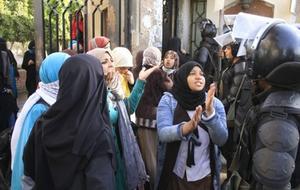TerrorismWomen more active in extremist Islamist groups than previously thought
About 10 percent of ISIS recruits from Europe, and about 20 percent of recruits from France, are women. Though they tend to play a supportive role in the Islamic extremism narrative, women can be just as radical. “What’s very striking is that she’s not an exception; she’s an example of a trend,” one expert says of Hayat Boumeddiene, the 26-year old partner of Paris gunman Amedy Coulibaly. “There tends to be an assumption with women that they’re doing it under influence, they’re being forced or tricked. But I think there’s a more complicated story here, feelings of alienation.”

Islamist women confront police in Cairo // Source: commons.wikimedia.org
Hayat Boumeddiene, the 26-year old partner of Paris gunman Amedy Coulibaly, is one of many European women believed to have traveled to Syria to join extremist groups such as the Islamic State (ISIS) and al-Qaeda. According to Jayne Huckerby, an associate professor at Duke University law school who studies terrorist groups and advises governments on counterterrorism strategies, women account for roughly 10 percent of ISIS recruits from Europe and about 20 percent of recruits from France. Though they tend to play a supportive role in the Islamic extremism narrative, women can be just as radical. “What’s very striking is that she’s not an exception; she’s an example of a trend,” Huckerby said of Boumeddiene. “There tends to be an assumption with women that they’re doing it under influence, they’re being forced or tricked. But I think there’s a more complicated story here, feelings of alienation.”
A childhood friend of Boumeddiene, speaking on condition of anonymity to the newspaper Le Parisien, described her as “impulsive,” emotionally fragile, and prone to sending religious text messages and venting about her growing sense of alienation as a Muslim.
The Los Angeles Times points out that as was the case with Cherif and Said Kouachi, the brothers who attacked the Charlie Hebdo office in Paris, Boumeddiene spent a few years as a ward of the state. One of seven children born in Paris to Algerian parents, she was sent to foster care at age twelve after her mother died and her father remarried. French newspaper Le Journal du Dimanche reported that Boumeddiene was expelled from foster homes for assaulting social workers, and later moved in with a friend in a Paris suburb. She met Coulibaly in 2007, shortly after he served time for robbery at Fleury-Merogis Prison, where he met Cherif Kouachi and other radical Muslims.
For the first few years as a couple, Boumeddiene and Coulibaly did not show any extremist views. Their social media photos included beach photos in which Boumeddiene wore a bikini and posed for photos alongside Coulibaly. They married in 2009 in a religious ceremony not recognized by the French government, French police union spokesman Christophe Crepin said. The couple later began to visit a Muslim extremists in central France, and in 2010 she posed for photos in which she wore a veil and aimed a crossbow at the camera. When counterterrorism investigators questioned Boumeddiene later that year, she spoke of “innocents killed by the Americans,” but insisted that Coulibaly was not a radical. “Amedy isn’t really very religious. He likes having fun,” she told the investigators.
French law enforcement did not have evidence or reason to charge or monitor Boumeddiene at the time so she was released from questioning. “Until we had proof to the contrary, we had to accept that she felt that way,” Crepin said.
Three years later, Coulibaly was sentenced to five years in prison for his part in a failed plan to break out from prison Smain Ait Ali Belkacem (planner of the 1995 Paris Metro bombings). He was released early in March 2014. Boumeddiene, then a friend of Cherif Kouachi’s wife, traded more than 500 cellphone calls with her in 2014.
“They used the women, it’s clear,” Crepin said of the attackers, adding that the women were likely aware of the men’s plans. “When there’s 500 calls going back and forth, they clearly had an idea of what was going on,” Crepin said. “We were dealing with people who knew they were being watched and knew how to avoid it. The women were not ignorant.”
Erin Marie Saltman, an expert on the role of women in extremism at the London-based Institute for Strategic Dialogue, said unlike some women who played a supportive role in Islamic extremism, “Boumeddiene was obviously very active, wanting to train, wanting to be a part of the violent nature of the jihadist ideology.”
Samia Maktouf, a Paris lawyer who represents families of several female Muslim extremists in France, said law enforcement should have monitored Boumeddiene earlier on. “They were aware of the dangerousness of this girl. She was in the hands of the police in 2010. Why didn’t they stop her or put her under surveillance? My answer is they were not aware of her Muslim fundamentalism,” Maktouf said.
French authorities are now looking to pass laws that will make it easier to monitor associates of terror suspects. “It was too difficult to monitor the women before. Now, maybe we will be able,” Crepin said. Boumeddiene is believed to have traveled to Turkey and crossed into Syria.
